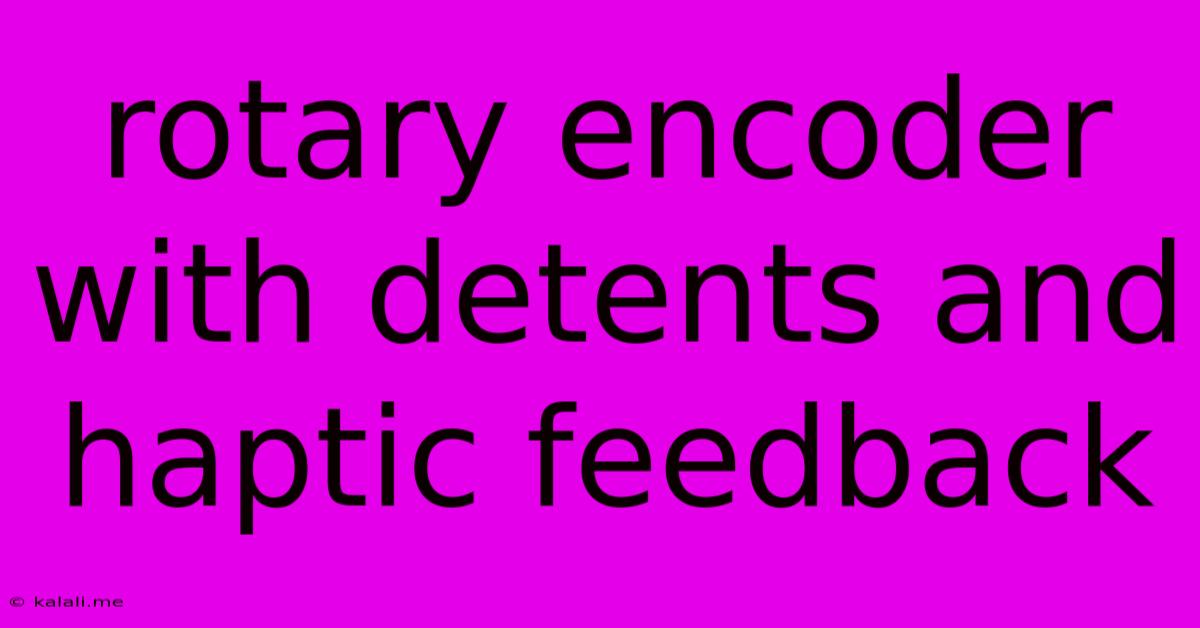Rotary Encoder With Detents And Haptic Feedback
Kalali
May 25, 2025 · 3 min read

Table of Contents
Rotary Encoder with Detents and Haptic Feedback: A Deep Dive
Rotary encoders are ubiquitous in various applications, from industrial automation to consumer electronics. This article delves into the specifics of rotary encoders featuring detents and haptic feedback, exploring their functionality, advantages, and applications. Understanding these features allows for informed selection when designing user interfaces and control systems demanding precise and intuitive interaction.
What is a Rotary Encoder?
A rotary encoder is an electromechanical device that converts angular position or rotational motion into digital signals. These signals represent the angle of rotation, providing precise positional information to a connected system. They are commonly used in applications requiring precise control, such as volume knobs, tuning dials, and industrial machinery. Different types of rotary encoders exist, including incremental and absolute encoders, each with its own characteristics and applications.
Understanding Detents: Clicky Feel for Precise Control
Detents, in the context of rotary encoders, are mechanical stops that provide distinct "clicks" during rotation. These clicks provide tactile feedback to the user, confirming each incremental movement. The presence of detents enhances the user experience by offering a tangible sense of control and precision. This is particularly crucial in applications where precise adjustments are essential, minimizing errors and ensuring accuracy. For example, a camera's aperture control ring with detents allows for more accurate adjustments compared to a smooth, detent-less version. The clicks act as clear markers, helping the user accurately dial in their desired setting.
Haptic Feedback: Enhancing User Interaction
While detents provide a purely mechanical form of feedback, haptic feedback introduces a more sophisticated element. Haptic feedback uses vibrations or other physical sensations to provide additional sensory information to the user. Combined with detents, haptic feedback amplifies the user experience by providing a richer, more informative interaction. For instance, a rotary encoder with both detents and haptic feedback could provide a subtle vibration when reaching a preset limit, alerting the user to avoid exceeding a safe range. This adds a layer of safety and prevents potential damage or errors.
Applications of Rotary Encoders with Detents and Haptic Feedback
The combination of detents and haptic feedback significantly enhances the usability of rotary encoders, making them ideal for a wide array of applications:
-
Industrial Control Systems: In machinery and automation, precise control is crucial. Detents and haptic feedback can prevent accidental adjustments and increase accuracy. Imagine a system controlling robotic arm positioning – the clicky feel and vibration feedback make precise movements much safer and reliable.
-
Medical Devices: The tactile and vibrational feedback are crucial in applications demanding precision and sensitivity, like controlling surgical instruments or adjusting medical equipment settings. The responsiveness and clear feedback mechanisms minimize errors in critical situations.
-
Consumer Electronics: From high-end audio equipment to advanced gaming controllers, the clicky feel and vibration responses provide enhanced user experience and intuitive operation. Think of the satisfying click of a high-quality volume knob on a stereo system, or the subtle vibrations of a gaming controller conveying in-game actions.
-
Automotive Applications: In vehicles, these encoders could be used in applications like climate control systems, providing a superior user experience over traditional dials. The user gains increased confidence in their adjustments.
-
Scientific Instruments: In labs and research settings, the ability to precisely adjust settings with clear feedback is valuable for reproducibility and accuracy in experimental settings.
Choosing the Right Rotary Encoder
Selecting the appropriate rotary encoder depends on the specific application requirements. Factors to consider include resolution (number of detents), the type of haptic feedback (intensity and frequency), durability, and environmental factors. The choice between an incremental and absolute encoder is also crucial, impacting the level of position information provided.
Conclusion
Rotary encoders with detents and haptic feedback represent a significant advancement in user interface design. The combination of mechanical clicks and vibrational feedback provides a robust and intuitive control mechanism, greatly improving accuracy, user experience, and safety in a wide range of applications. The careful consideration of these features is vital when choosing the right encoder for your specific needs, ensuring optimal performance and user satisfaction.
Latest Posts
Latest Posts
-
How To Keep Groundhogs Out Of Garden
May 26, 2025
-
Oil Based Vs Water Based Poly
May 26, 2025
-
How To Take A Small Dent Out Of A Car
May 26, 2025
-
Dogs Begin To Smell Her Lyrics
May 26, 2025
-
Was Daniel Of The Bible A Eunuch
May 26, 2025
Related Post
Thank you for visiting our website which covers about Rotary Encoder With Detents And Haptic Feedback . We hope the information provided has been useful to you. Feel free to contact us if you have any questions or need further assistance. See you next time and don't miss to bookmark.